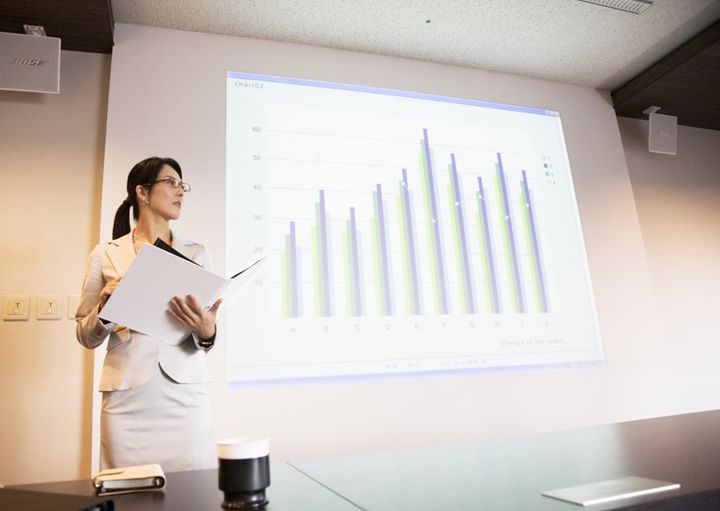
Ever heard that Jerry Seinfeld joke about public speaking?
"According to most studies, people's number one fear is public speaking. Number two is death. Death is number two. Does that sound right? This means to the average person, if you go to a funeral, you're better off in the casket than doing the eulogy."
Funny, right? Except to some people, public speaking is anything but.
One of the most common phobias in the world, what makes glossophobia (or the fear of public speaking) particularly unique is that, unlike the fear of spiders, snakes or heights, public speaking is a skill often required in both workplace and social environments.
So is it possible to conquer your public speaking phobia? And if so, how?

"It can be really crippling," public speaking trainer, coach and keynote speaker Peter Dhu told The Huffington Post Australia. "In my workshops, people will often tell me they put their career on hold just to avoid it.
"Often it's before the event -- in the days and nights leading up -- that they will really suffer. They'll have sleepless nights and worry about it all the time... It's one of those things that holds people back.
"Certainly in terms of careers, if you happen to be an introvert, it can be problematic. Public speaking and the ability to contribute to meetings and stand up and present all tend to be considered to be leadership qualities. Avoiding it altogether does seem to hold people back in their careers."
As for whether you can ever kick your public speaking fear for good, Dhu says unfortunately not.
"As long as you continue to do public speaking, the fear is never going to go away," Dhu said.

"To use a quote from the author Mark Twain; 'There are two kinds of speakers in the world. Those who are nervous, and those who are liars.'
"That's actually one of the first things I let people know. The fear and the nerves never go away."
But Dhu insists this isn't necessarily a bad thing, stating it's more about learning how to manage the nerves than eradicating them altogether.
"Nerves and a healthy level of fear and anxiety is actually normal," Dhu said. "It's about harnessing that nervous energy rather than diminishing it or obliterating it.
"As a speaking trainer, I get nervous before every presentation. The day I'm not nervous, I'm probably not giving the audience the due respect and courtesy they deserve. I'm probably just going through the motions.
"Nerves and anxiety are part of our flight or fight response, and can actually put you in that peak performance mode. Athletes, for instance, like to get into that peak performance mode. They don't want to get so calm they miss the starter's gun and they don't want to be so nervous they jump the starter's gun. You want that healthy anxiety in the middle that puts you in that peak performance mode."

Interestingly, Dhu says one of the biggest misconceptions when it comes to a fear of public speaking surrounds how the speaker feels he or she is being perceived by the audience.
"It's really important to understand that whatever is going on for you, the audience doesn't see it," Dhu said. "Your heart rate may have gone up, you might have sweaty palms or a slight quiver in your voice, but most of the time the audience doesn't know.
"It's what we like to call the Anxiety Reality Check. Sure, your reality might be real, but it's not the audience's reality."
People are more accepting and less critical than you think.. Generally, the most critical person in the room is yourself. Catherine Madigan, clinical psychologist
"What I find in my workshops time and time again is someone will stand up and speak, and afterwards I will ask them to self-assess how nervous they were," Dhu continued. "Then I'll ask the audience, 'how did that person look to you?'
"Nearly always, the person speaking puts themselves at an eight out of ten for nervousness or anxiety, while the people in the audience will put them at a four or a five out of ten. They'll say, 'nothing indicated to me you were dying in your boots as you indicated. I wish I could be as good as you,' while the person who spoke will be saying 'are you kidding? I was terrible.'
"When you can accept that the audience's perception is at least twice as good as you perceive yourself and run with that, you can allow those nerves to be there but not impact you too much."
It's a sentiment echoed by clinical psychologist Catherine Madigan of Anxiety Treatment Australia.
"People are more accepting and less critical than you think," she told HuffPost Australia. "But you're only going to learn this if you let the 'real you' out there for people to see. This can be a bit confronting for people. But generally the most critical person in the room is yourself."

In fact, both Dhu and Madigan say one of the most important parts of public speaking is communicating a sense of who you are and what your message is to the audience... without the bells and whistles.
"Some people who seem to get rid of their nerves and seem to be really calm and confident can actually hit their audience with verbal diarrhea and end up having no impact," Dhu said. "They might love the sound of their voice and for them, public speaking is about stroking their ego. This is a sure-fire way to have no impact because it's all about them.
"Another person will tell you they're dying in their boots and are really nervous, but they will share an honest and meaningful message with the room and have a much bigger impact."
"Basically what people need to believe can be summed up in this little quote," Madigan added.
"I got this from a conference, so it's not my quote, but I think it's really good. It's: 'I am acceptable as I am. I don't need to cover up. I don't need to hide. I don't need to do my safety behaviours. I am the most critical person in my universe. My head is more threatening than this social environment'."

In terms of the 'safety behaviours' Madigan refers to, these can include things such as over-preparing, rushing, hiding behind distractions such as hand-outs or a PowerPoint presentation or plain old Dutch Courage.
"You have to get out there and do it. You can't be avoiding it. You don't want to be using crutches," Madigan advised. " A lot of people might turn to alcohol. How many wedding speeches have been made under the influence of alcohol?
"Other safety behaviours might be people running through their speech like they are calling the horse races, trying to get through as quickly as possible. That's just another method of avoidance. You want to focus on speaking slowly and loudly and making eye contact with the audience.
"Another safety behaviour is when people over-rehearse or don't rehearse at all. So, for instance, if you had to give a presentation in a week's time, over-rehearsal might be doing absolutely nothing for that whole week but rehearse for that presentation. We're talking an unreasonable amount of rehearsal.
"Others won't want to at all because it reminds them they have to do it. It's about finding a happy medium -- you want to rehearse a little bit bit, but not excessively."

"Some people who give work presentations will rely on lots of hand outs or a PowerPoint presentation to take the attention off themselves," Madigan continued. "The thinking is, 'if I give out the hand outs, people will look at the hand outs rather than look at me.'
"The same with PowerPoint. But if the computer system went down, you wouldn't want to be so reliant on the PowerPoint as something to hide behind that you go into a meltdown because you think people are focused on you.
"In a similar vein, many people keen to stand behind a desk or stand behind a lectern and will find it extremely hard to present without something to hide behind.
"These are all crutches or safety behaviours people use, and they need to target practicing not having these crutches. At the end of the day, you need to not be frightened of blushing or sweating or shaking and not hiding these things."
While this might seem easier said than done, Dhu recommends employing a number of tricks or, as he calls them 'reframes' to help you through.
Have a conversation
"Don't think of it as public speaking," Dhu advised. "Reframe it and have a conversation. For instance, how I'm talking to you now is how I'd talk to 150 people. I wouldn't try to be fancy or try to put a plum in my mouth, I wouldn't try to eliminate my um's and ah's.
"Think of it as having a one-on-one conversation with 150 people."
Get excited
"Instead of being nervous, get excited," Dhu said. "If you look at the biochemistry of nerves, the body's adrenaline flows, the heart beats faster, the arms get sweaty... but those are also symptoms of excitement.
"When you get nervous, same things happen biochemically as when you get excited, so make the choice which one you're going to be."
Be present
"Nervousness is a state of selfishness," Dhu said. "You are standing up in front of a group of people who need your knowledge. They need your information. But you've decided you're going to worry about what's happening to you.
"You're going to rob the audience of what they need because you are worrying about yourself. Instead, try to be present. Focus on what their needs are. After all, they have invested the time and possible money to hear what you've got to say.
"If you can't be present for you, you can't be present for them."
Prepare (a healthy amount)
While over-preparation can be classified as a safety behaviour, a healthy amount of preparation can be extremely helpful.
"Do your preparation. Know your topic. Know your audience," Dhu advised. "Where is the venue? Know how far away it is so you're not late.
"Make sure the audio visual equipment is up and running. Make the AV guy your best friend.
"Find out if you need to acknowledge the traditional land owners or if there there has already been a welcome to country.
"This sort of preparation should help to bring the anxiety down a little notch."

Practice
It's probably the last thing you feel like doing, but Dhu says practice is vital when it comes to public speaking.
"It is not an occasional skill," he said. "It's not like riding a pushbike, where if you haven't ridden one for 12 months, you can still do it without a problem.
"I would say, at minimum, you need to get on your feet once a fortnight."
Get feedback
"What I see in my workshops is what people think they did and what the audience saw are two different things," Dhu said. "As such, it's important to get feedback. Feedback is how you grow, feedback is how you learn.
"People can say what they liked, what worked, what [the speaker] can change or do differently. Sometimes the feedback isn't relevant. Sometimes it's very relevant and you'll learn from it. But it helps to know if you are doing a good job, and you're probably doing much better than you think."